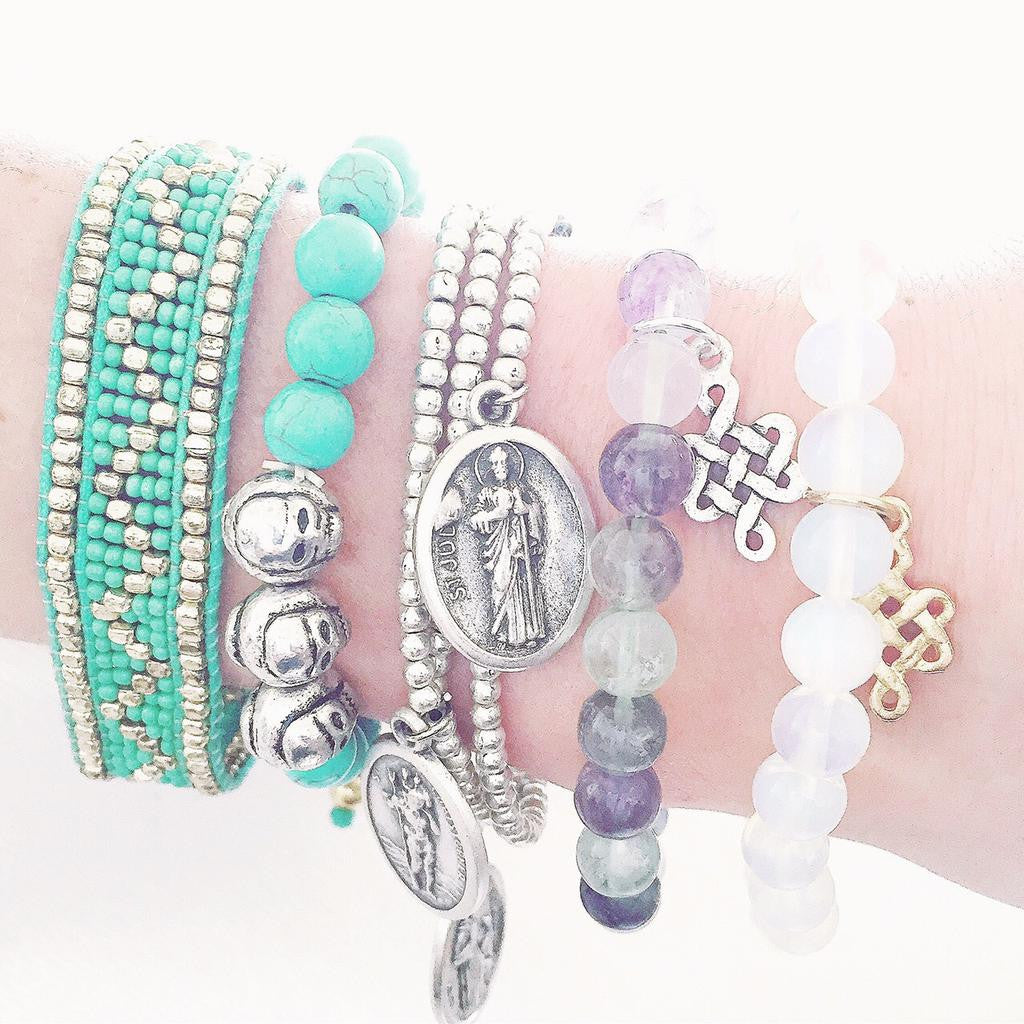The Hamsa (containing the Evil-Eye) is a palm-shaped amulet popular throughout the Christian community of Goa, India and commonly used in jewelry and wall hangings.
(Hamsa as seen in Hamsa Bracelet Set)
The indigenous population of the erstwhile Portuguese colony of Goa underwent a large-scale conversion to Christianity after its conquest and occupation by the Portuguese Empire, led by admiral Afonso de Albuquerque in 1510. After conversion to Roman Catholicism, they were usually granted Portuguese citizenship.[1] Almost all the present-day Goan Catholics are descendants of these local converts to the religion. They constitute the largest Christian community in Goa and account for 25 per cent of the total Catholic population in India.[2] TheMangalorean Catholic and Karwari Catholic communities of the Indian state of Karnataka are also largely descended from these Goan converts.
During the mid-16th century, the Portuguese colony of Goa, especially the city of Goa, was the center of Christianisation in the East.[4] Christianisation in Goa was largely limited to the four concelhos (districts) of Bardez,Mormugao, Salcette, and Tiswadi.[5] Furthermore, evangelisation activities were divided in 1555 by the Portuguese viceroy of Goa, Pedro Mascarenhas.[6] He allotted Bardez to the Franciscans, Tiswadi to theDominicans, and Salcette, together with fifteen southeastern villages of Tiswadi, including Chorão and Divar, to the Jesuits.[6] The city of Velha Goa was shared among all, since all the religious orders had their headquarters there.[6] Prior to that, the Franciscans alone Christianised Goa till 1542.[7] Other less active orders that maintained a presence in Goa were the Augustines, Carmelites, and Theatines.[8] The first mass conversions took place among the Brahmins of Divar, and the Kshatriyas of Carambolim.[9] In 1534, Goa was made a diocese and in 1557 an archdiocese. The Archbishop of Goa was the most important ecclesiastic of the East, and was from 1572 called the "Primate of the East".[10] While the Portuguese rulers implemented state policies encouraging and even rewarding conversions among Hindu subjects, it would be false to ascribe the large number of conversions solely to force. On the contrary, the rapid rise of converts in Goa was mostly the result of Portuguese economic and political control over the Hindus, who were vassals of the Portuguese crown.[11
This process of Christianisation was simultaneously accompanied by Lusitanisation, as the Christian converts typically assumed a Portuguese veneer.[12] The most visible aspect was the discarding of old Hindu names for new Christian Portuguese names.[12] The 1567 Provincial Council of Goa—under the presidency of the first Archbishop of Goa Gaspar Jorge de Leão Pereira and after his retirement under that of George Themudo, Bishop of Cochin—passed over 115 decrees.[13] One of them declared that the Goan Catholics would henceforth not be permitted to use their former Hindu names.[13] Consequently, the converts typically had to adopt the surnames of the Portuguese priest, governor, soldier or layman who stood as godfather for their baptism ceremony.[12] For instance, the Boletim do Instituto Vasco da Gama lists the new names of some of the prominent ganvkars (Konkani: Freeholders). Rama Prabhu, son of Dado Vithal Prabhu from Benaulim, Salcette, became Francisco Fernandes; Mahabal Pai, son of Nara Pai, became Manuel Fernandes in 1596. Mahabal Kamati ofCurtorim became Aleisco Menezes in 1607, while Chandrappa Naik of Gandaulim became António Dias in 1632. In 1595 Vittu Prabhu became Irmão de diago Soares and the son of Raulu Kamat became Manuel Pinto inAldona, Bardez. Ram Kamat of Punola became Duarte Lobo in 1601, while Tados Irmaose of Anjuna became João de Souza in 1658.[14] Since in many cases, fathers and sons were not necessarily baptised in the presence of the same godfather, this would lead to them having different surnames.[15] For instance in 1594, the son of Pero Parras, a ganvkar from Raia acquired at baptism the new name of Sebastião Barbosa. Later in 1609, another of his sons converted and took the name of João Rangel.[15] As a result, members of the same vangodd (clan) who initially all shared a common Hindu surname ended up adopting divergent Lusitanian ones.[15
However, the converted Hindus retained their mother tongue (which in most cases was Konkani) and caste status, even after becoming Christian.[16] Based on their previous caste affiliations, the new converts were usually lumped into new Catholic castes. The converts from the priestly Brahmin class were Bamonns (Konkani: Brahmins).[17] All Brahmin subcastes such as the Goud Saraswat Brahmins, Padyes, the Daivadnyas, and especially the goldsmiths and a few merchants, were lumped into the Christian caste of Bamonn.[17] The converts from the Kshatriya and Vaishya Vani castes became Chardos (Kshatriyas);[17] and those Vaishya Vanis who couldn't become Chardos formed a new caste Gauddos.[18] Those converts from the Gaudas, Kunbis and other lower castes were grouped together as Sudirs, equivalent to Shudras.[19][20] The Bamonns, Chardos, and Gauddos have been traditionally seen as the high castes in the Goan Catholic caste hierarchy. (wikipedia)
Generally in Goa also, the Madonna for example, is depicted in flowing garb that is almost sari-like, and her feet rest on a crescent moon or medialuna. The crescent moon rests on a sphere representing the world. Since many Goans converted to Christianity under the Portuguese, local religious art developed syncreatic elements: it was predominantly Christian but incorporated Hindu Indian influences. Christians in the Middle East incorporate the Hamsa and evil- eye as well into their religious images and relics.






